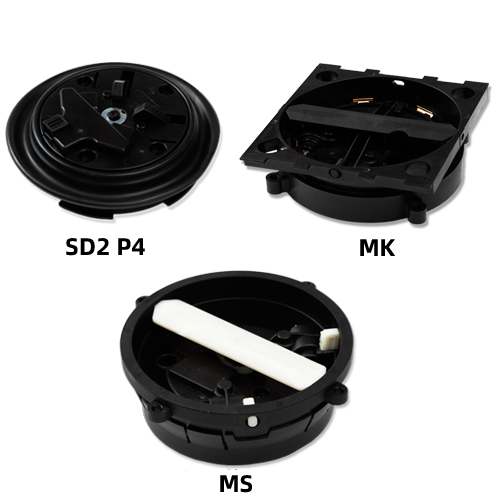How does the headlamp regulator work? It’s a stepper motor. If you push it, it moves. If you don’t give it some energy, it’s going to stay there. Not since the blackout. Stepper motor is an open-loop control element which Converts Electric Pulse Signal Into Angular or linear displacement. In the case of no overload, the motor speed and stop position only depends on the frequency and number of pulse signals, and is not affected by the load change, that is to add a pulse signal to the motor, the motor rotation of a stepping angle. The existence of this linear relationship, plus stepper motor only periodic error, no cumulative error. Stepper motor control speed, position and so on is very simple. Although stepper motor has been widely used, but stepper motor can not be the same as ordinary DC motor, in the general use of AC motor. It must be composed of double-loop pulse signal, power supply drive circuit and so on. Therefore, it is not easy to use a good stepper motor, which involves mechanical, electrical, electronic and computer expertise. At present, the production of stepping motor manufacturers is indeed many, but with professional and technical personnel, can develop their own few manufacturers, most manufacturers only one or 20 people, even the most basic equipment is not. This is just a blind imitation. This gives the door in the choice of products, a lot of trouble. In view of the above, we decided to use the example of a wide stepping motor. Describe how it works. Hope to be able to the majority of users in the selection, use, improve the whole machine when helpful.The working principle of stepping motor (1) the working principle of stepping motor, the working principle of stepping motor is relatively simple. First of all, the working principle of the three phase reaction stepper motor is introduced. Structure: There are many small teeth evenly distributed on the rotor of the motor. There are three excitation resistors around the stator teeth. 0,1/3,2/3, (the distance between the teeth of two adjacent rotors is denoted by the Tooth Pitch) , that is, a is aligned with Tooth 1, B is offset 1/3 from the right of Tooth 2, C is offset 2/3 from the right of Tooth 3, and a is aligned with tooth 5, (A’is a, tooth 5 is Tooth 1) below is the expansion diagram of the stator and rotor: Rotation: If the stator is electrically connected, B, C is electrically connected, Tooth 1 is aligned with a due to the magnetic field (the rotor is not affected by any force below the magnetic field) . If B is charged and a and C are not, tooth 2 should be aligned with B. When the rotor moves more than 1/3 to the right, tooth 3 and C move 1/3, tooth 4 and a move (change 1/3) = 2/3 change. If C is electrically connected and A and B are electrically disconnected, tooth 3 should be aligned with C as the rotor moves to the right of 1/3, and Tooth 3 should be aligned with C as Tooth 4 moves to the right of 1/3. If a is inserted and B C is not inserted, tooth 4 is aligned with a, when a B C A is inserted, the rotor moves 1/3 to the right, tooth 4(the first tooth of Tooth 1) moves to Class A, the rotor of the motor rotates one tooth pitch to the right, and if you continue to start with a B C A, turn the motor 1/3 to the right at each step (pulse) . Press A, C, B, A. Then the engine turned Therefore: the Motor Position and speed by conduction time (pulse time) and frequency one-to-one relationship The direction is determined by the conduction order . .However, taking into account Torque, stability, noise and angle reduction. A-AB-B-BC-C-CA-A is usually used as a conducting state, from 1/3 to 1/6 per step. Even through the different combination of two-phase current, so that 1/3 to 1/12,1/24, which is the basic theory of motor subdivision drive. It is not difficult to deduce: Motor stator has m phase excitation winding resistance, its shaft and rotor gear shaft offset 1/m, 2/m... (m-1)/M, 1. According to a certain phase-sequence motor can conduct positive and negative rotation, which is the physical conditions of rotation. As long as we meet this condition, we can theoretically make the stepper motor at any stage, out of cost and other considerations, the market is generally two, three, four, five stages for more. Torque: once the motor is energized, a magnetic field (flux) is generated between the stator and rotor. When the rotor and stator stagger at an angle, the force F is proportional to the magnetic flux of its (magnetic induction θ) s = Br * S, s is proportional to the conductive area F, l * D * Br is the effective length of the core and D is the diameter of the rotor, br = NI/R NI is the ampere turn (the turns of the current multiplier) of the excitation winding, and r is the magnetoresistance effect. Torque = radius of force, Torque is proportional to the effective volume of the motor, ampere turns, magnetic field density (linear only) . Therefore, the larger the effective volume of the motor, the greater the number of excitation ampere turns, the smaller the air gap between the stator and rotor, the greater the Torque of the motor, and vice versa.

